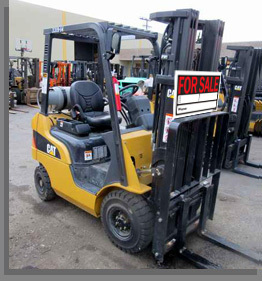How to Buy a Forklift
Buying forklifts is a process. Prepare properly, and the process works for you.
I’ve worked in this industry for 37 years. In that time I’ve bought and sold a lot of forklifts. I learned all the things to consider when you buy a forklift. Things you should consider too.
If you know these 7 elements, you’ll walk into a forklift dealer well prepared to buy a forklift. The buying process will go smooth and simple. Let’s get started.
Element 1: How Big & How Heavy are Your Typical Loads?
Most of the time, pallet loads fall within the same size & weight. 90% of the material handling industry uses GMA (Grocery Manufacturers Association) standard pallets (48” long x 40” wide). 95% of pallet loads don’t exceed 2000lbs.
If you want to double-stack in trailers, then you’ll want a 5000lb capacity forklift. 65% of forklifts are 5000lb cushion type (LPG or Electric), pneumatic type or cushion/pneumatic electric. Forklifts are designed at a 24” load center, which means it can handle a 4 foot load at its rated capacity.
Element 2: How High Do You Need to Lift the Loads?
90% of all forklifts are 188” lift height. That also allows a down height of 83-85”. This common lift height hasn’t changed for 50 years.
The 188” triple stage came about with 3-high stacking, with 60” between the load beams on racks and 90” trailer openings. Do you have tall ceilings in your warehouse? Use them! Price per pallet position will drop.
Element 3: Will You Use the Forklift Indoors, Outdoors, or Both?
If you plan to use your forklift on any type of non-smooth cement surface, then you should buy a pneumatic. However, a 5000lb pneumatic type forklift costs more, and alters your turning radius to 14-foot aisles. (Cushion type LPGs and Electrics have a 12-foot radius.)

Element 4: How Much Room Do You Have to Maneuver?
If you want to maximize the number of pallets your warehouse can hold, you may opt for narrow aisles (less than 12 foot). With narrow aisles, you’ll need to look at a 3-wheel electric type forklift (indoor/outdoor), or stand-up trucks. You can get even narrower (80 inch) if you look at Aislemaster electric lifts.
Remember though: Set your warehouse up based on your input/output of goods. Determine your aisle requirements by the most efficient pallet positions. Then determine your forklift requirements based on the aisle requirements.
Element 5: How Many Hours Per Day Will Your Team Use the Forklift?
A good rule of thumb: If you plan to use the forklift more than 4 hours a day, buy or lease a new forklift. If your need isn’t that great, used forklifts should fit the bill. Once you establish the hours needed, you can set a budget.
(We talked about Forklift Cost per Hour last issue. It can help you estimate how many hours you want to use the forklift daily, balanced against lifetime value.)
Prefer used anyway? You’ve got a huge selection to choose from. But remember the old adage—you get what you pay for.
Element 6: What’s Your Budget?
Think of a forklift purchase as Silver, Gold, or Platinum.
- A “silver” purchase is a 5-year-old forklift with less than 6000 hours on it, at 60% of new price. Remember pricing for a new 5000lb forklift is approaching $25,000. Your budget is thus $15,000.
- A “gold” purchase is a 3-year-old forklift with around 3000 hours on it, at 75% of new price. Look into 5-year financing for a low monthly payment.
- A “platinum” purchase is a new forklift. No hours on it, full price. You’ll have the longest lifetime usage, but also the highest budget needs.
If you’re looking at electric forklifts, your #1 requirement is getting a new or 80% reconditioned battery. New batteries average $5,500. Also, get a good warranty in writing, and a high-frequency charger (25% better efficiency than the standard electric chargers).
Element 7: The Forklift Dealer
The final element to consider is the Forklift Seller/Dealer themselves. For the most part, you will have a good buying experience with most dealers. But, it always pays to do your homework. Look at 2-3 good forklift dealers and make your decisions from there.
With a dealer, check to see if they do their own maintenance. They should. Forklifts do break, but with preventative maintenance, you cut down on breakdowns. Ask the dealers about maintenance programs for the life of the forklift.
Look at the maintenance leases carefully. Make sure there are no hidden costs. If someone comes in with low labor rates, it’s usually for a reason. Avoid them.
Always remember the safety features that go with a forklift. I would urge you to require back-up alarms, strobe lights, headlights, and seatbelts on your trucks.
Knowing What Kind of Forklift to Buy Makes for Long-Term Satisfaction
When buying a forklift, you’re also choosing a forklift dealer that has the assets to support you. The dealer will provide the service and support to keep your lifts running smoothly, so it is important that you find one who is reputable, stable, and can provide top-notch service.
I hope this information helps you prepare for your next forklift purchase. We at Cromer want all our customers to have confidence in every forklift they buy, right from the start.
A good forklift dealer will understand what you’re looking for, if you use these elements to prepare.
(P.S. – Cromer Material Handling has 7 branches, 80+ technicians, 12+ parts personnel and over $15,000,000 in assets. We will do a great job on your next forklift purchase. www.cromer.com and.)
Everybody have a safe and happy Halloween!
Until next month,
Marshall Cromer, The Forklift Boss
Cromer Material Handling


